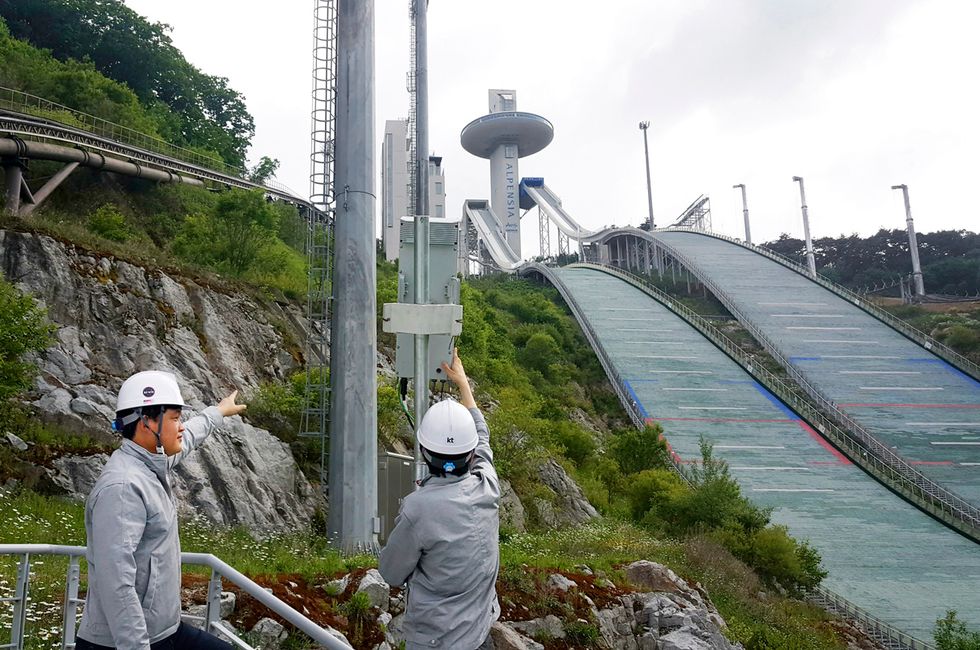5G’s Olympic Debut
This year’s Winter Games promise a sneak peek at a high-bandwidth, low-latency wireless future

Welcome to the 5G Olympics, where Nathan Chen, the 18-year-old figure-skating phenom, has just landed another quadruple jump. Can’t see him well from your seat in the nosebleed section? No problem. Just slip on your 5G virtual reality headset for a 360-degree rink-side view! Now watch your step—we’re boarding the 5G bus to the next attraction. Check out the windows: They’re in fact transparent display screens providing ultrahigh-definition video—streamed live—from a hockey player’s headcam, from drones flying above the ski slopes, and from the cockpit of a bobsled barreling down an icy track at 100…120…150 kilometers per hour!
That’s what you can expect next month at the Winter Olympics in Pyeongchang, if South Korea’s telecommunications companies are to be believed. KT Corp. (formerly Korea Telecom), the Games’ official sponsor, has announced plans for the first big test run of networking technologies that could herald peak download rates up to 100 times as fast as today’s 4G systems, with delays as low as 1 millisecond.
Not to be outdone, KT’s competitors SK Telecom and LG U+ are preparing their own 5G Olympic demos. Meanwhile, the South Korean government and the European Union have teamed up to fund still another trial, dubbed 5G Champion, that will include a broadband link between the Olympic Games and a 5G test-bed in Finland.
It’s understandable why they’re all jumping on this bandwagon. After all, there’s no bigger stage for showcasing the possibilities of a new technology than the Olympics. Just as past Games introduced the world to television (Berlin, 1936), satellite broadcasting (Tokyo, 1964), fiber optics (Los Angeles, 1984), and the CCD camera (Barcelona, 1992), Pyeongchang could give spectators a glimpse at the 5G future.

But the mobile industry may be promising more than it can deliver. And KT and SK Telecom have been suspiciously reticent to share details about exactly what they plan to demonstrate at the next Olympics. “I think hype is a good word” to describe what’s been advertised, says Michael Thelander, the president and founder of Signals Research Group.
5G networks, like their 4G LTE predecessors, will evolve in stages, with the first global standards set to arrive later this year. But consumers will likely have to wait until at least 2019 to buy 5G phones and tablets. “There’s no way in hell there are going to be commercial services [at the Pyeongchang Olympics] based on something that’s standardized,” Thelander says.
“At best,” says Henning Schulzrinne, a former advisor to the U.S. Federal Communications Commission and a professor at Columbia University, “what will be demonstrated are some early lab prototypes that will look roughly similar to what 5G standards will eventually incorporate.”
Indeed, KT is deploying its pilot system based on its own “Pyeongchang 5G Specifications.” Exactly what that pilot system will entail is unclear. “We’ve been adding functionalities and capabilities as we go,” says Jawad Manssour of Ericsson-LG, a joint venture of Sweden’s Ericsson and South Korea’s LG Electronics, which is supplying the system’s “end-to-end” infrastructure, from the core network to the radio base stations.
What is clear is that the system will provide digital communications at 28 gigahertz, a spectral band that will likely play a big role in 5G networks because it offers vastly more bandwidth than traditional cellular channels below 6 GHz. Operators have long avoided such high frequencies—also known as millimeter waves—because they don’t pass as easily through objects or even the air.
5G pioneers have attacked this problem by sending and receiving signals using compact arrays of hundreds of antenna elements. By adjusting the signals sent to each element, they can direct radio energy in concentrated beams, increasing gain as the beams follow mobile users through what could be a very cluttered environment. This scheme, called massive MIMO, also allows base stations to use the same frequencies to connect with many users at once, thereby making more efficient use of limited spectrum.
In addition, Pyeongchang’s 5G-flavored digital networks will make good use of virtualization, whereby basic networking functions such as caching and routing—which traditionally require dedicated hardware—will instead be carried out by software. This setup lets operators reconfigure a network or deploy new services quickly and cheaply using virtual machines running on generic hardware. Virtualization will likely be common in 5G architectures, which will need to accommodate many different wireless products—including driverless cars, smart appliances, and industrial robots.
“You need so many pieces to fall in the right place at the right time to make things work,” Manssour says. The Pyeongchang trials will show if that’s now possible, but they are only the beginning. “It’s still early days,” he says. “With these precommercial systems, the goal is just to give users a feel of what they could get with 5G. What the commercial networks will be—we’ll have to wait and see.”
This article appears in the January 2018 print issue as “5G Goes for the Gold.”


